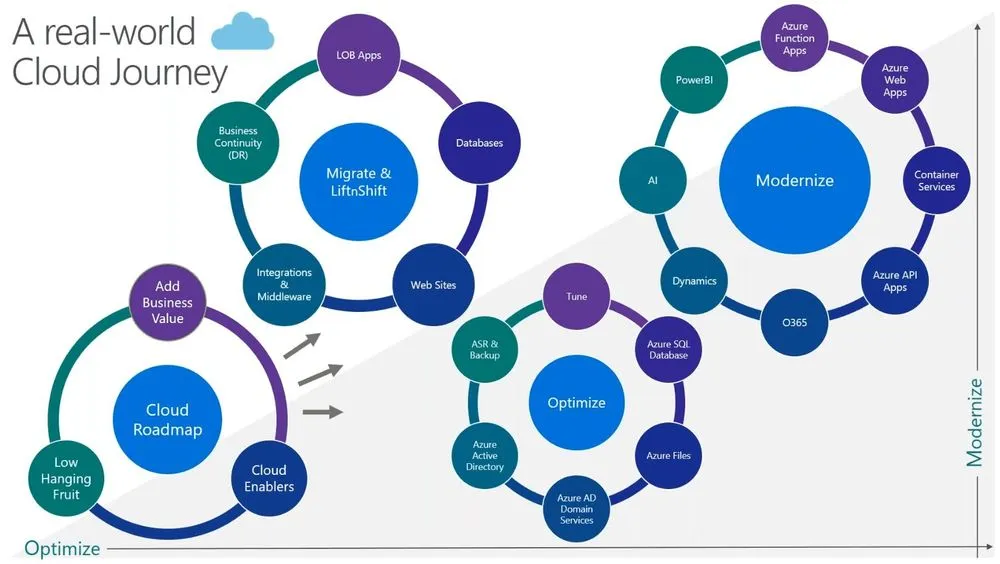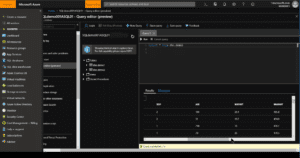Application Modernization - Azure SQL Migration Demo (Video)
Explore Cloud App Security with Agile IT's demo video, showcasing how to safeguard your data in Office 365 and beyond, ensuring comprehensive cloud security.

Tech Talks are a weekly opportunity to learn how to do more, and do it securely with your cloud software and services. Each week, we host a short talk from a subject matter expert, followed by a community driven Q&A where Agile IT’s clients can ask our engineers any of their most pressing questions. This is a free service for our clients. August 30th’s Tech Talk featured Rich Carlsen, Microsoft Cloud Solutions Architect who provided a easy to follow Azure SQL Migration demo. In this demo you learn how to migrate and existing SQL database to an Azure Virtual Machine.
Application Modernization Strategies on Azure
Rich began by showing how Application Modernization fits into the overall cloud journey of an enterprise, from generating a roadmap to full modernization, taking advantage of all the benefits cloud computing can offer.
A Real World Cloud Journey
Cloud Roadmap
To begin, it is important to have a roadmap. Identify what will actually add business value and focus on projects that are easy targets for moving to the cloud, then the cloud enablers, which are already built in the cloud, or are incredibly easy to migrate.
- Business Value
- Low Hanging Fruit
- Cloud Enablers
Migrate and Lift n’ Shift
Next, look at what can be moved to the cloud without completely rebuilding. Virtual servers allow you to run many legacy line of business apps in a virtual server instead of a costly local machine, databases can be moved easily to AzureSQL. Backups and business continuity is probably the most obvious of these shifts, as data recovery gains exponentially more utility in the cloud.
- Line of Business Apps
- Databases
- Websites
- Integrations and Middleware
- Business Continuity (Data Recovery)
Cloud Optimization
It is debatable whether optimization or modernization is the true next step in the cloud journey, and it largely depends on your business. In optimization, you begin to make the updates and changes that allow you to take full advantage of the benefits of the cloud. Domain controllers, active directory, file servers, and site backups are all capable of greater functionality and ease of use in the cloud, but it does require changing the way some of your systems operate.
- Azure SQL Database
- Azure Files
- Azure AD Domain Services
- Azure Active Directory
- Azure Site Recovery and Backup
Modernize
In cloud modernization, you begin to take full advantage of the cloud. Here you gain capabilities that would be prohibitive or even impossible with standard infrastructure. Business intelligence and artificial intelligence are two great examples of functions that are incredibly difficult to implement with a traditional on-premises infrastructure.
- Azure Function Apps
- Azure Web Apps
- Container Services
- Azure API Apps
- Office 365
- Dynamics
- Artificial Intelligence
- Power BI
Azure Migration Tools
(These are available in your Azure Portal)
- Azure Migrate - Easily Discover, Assess, right-size, and migrate your on-premises VMs to Azure
- Azure Database Migration Service - Simplify on-premises
- Cost Management - Optimize what you spend on the cloud, while maximizing cloud potential
- Site Recovery - Orchestrate protection and recovery of private clouds
- Data Box - Secure, rugged appliances for Azure data transfer
Azure Database Migration Tools
Microsoft Data Migration Assistant 4.0 Azure Database Migration Service
The Demo
 (Click here to jump right to the demo) For the demo, Rich had already provisioned all of the needed virtual machines, including a VM running SQL that would be migrated to Azure, then from there it would be further migrated to an Azure SQL instance. Using open source health data to populate the database.
(Click here to jump right to the demo) For the demo, Rich had already provisioned all of the needed virtual machines, including a VM running SQL that would be migrated to Azure, then from there it would be further migrated to an Azure SQL instance. Using open source health data to populate the database.
On the source VM, he demonstrated how to select his data sources, and showed the results of a the SQL Server feature parity assessment that showed that there were no databases affected by unsupported features or partially supported services, the assessment checked 140 comparability DB issues and came up clean. Moving on to the migration, he selected the two tables he planned on migrating. The migration itself was as simple clicking a button to generate a schema creation script then clicking the button to “Deploy schema”.
Moving back to the Azure Portal, he showed that the schema was in place. He moved into the Azure Database Migration Project where he showed the migration wizard, which simply asked for the Source SQL Server instance name, the authentication method and for the DB user credentials. Migration target details had the same questions.
Once the source and target are selected, Rich mapped the target database, which consisted of verifying the name, and selecting the desired tables. After selecting the validation options, he simply clicked migrate and it was done in a few seconds.
Bonus Materials
Ever generous, Rich shared a number of cool resources:
- How to assess and rehost your application (Video)
- Get Started with Azure
- Migrate to Azure
- Application Modernization Source Code
Plus 3 free Azure related eBooks:
- The Developer’s Guide to Microsoft Azure
- Modernize Existing .NET Applications with Azure cloud and Windows Containers
- .NET Microservices: Architecture for Containerized .NET Applications
Still on SQL 2008?
The July 9th, 2019 end of support for SQL Server 2008 and SQL Server 2008 R2 is upon us! This end of free security updates is going to leave your databases vulnerable. Even if you aren’t ready to update, Microsoft is offering an additional 3 years of Extended Support on SQL 2008 databases that shift to hosting on Azure Virtual Machines. Additionally, by working with Agile IT, you can save up to 55% if you use your existing licenses to migrate to Azure SQL with Azure Hybrid Benefit. Request a quote to find out how our managed DevOps services can make this a seamless migration.





